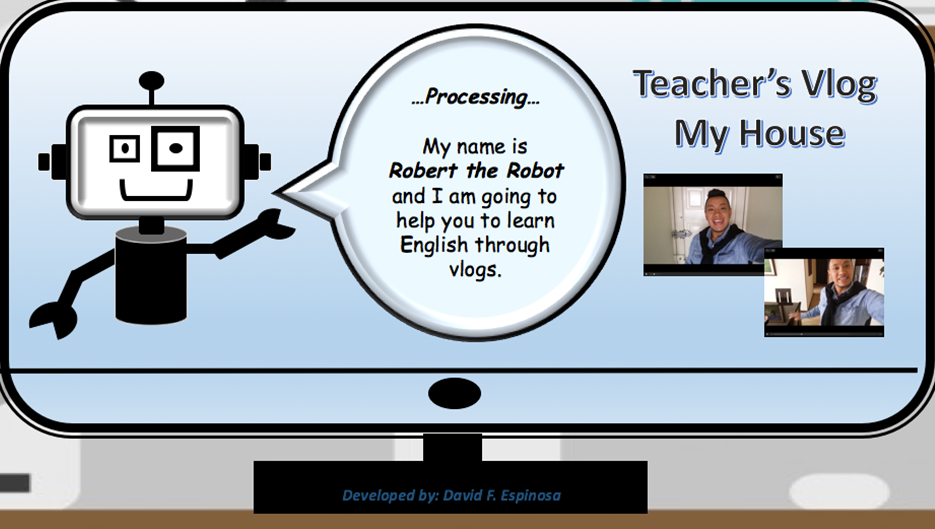24 de mayo de 2018
Vlogging Through Virtual Lessons: A Competence for the Twenty-First Century
David Felipe Espinosa T., M.A.
This present article aims at describing the creation and implementation of lessons focused on video blogs (vlogs) as digital materials, to enhance students’ speaking in a blended learning environment. It also argues the need of stimulating learners’ motivation for using technology to enhance their speaking, and raise their learning enthusiasm and self-confidence. Thus, a series of materials development (MD) principles are proposed so as to support this pedagogical strategy.
Nowadays, revolutionary means of communication, such as computers and mobile phones, have been incorporated to education as a way of creating spaces where students are fully engaged in the process of learning a foreign language. Global communication has brought different tech-tools to support pedagogical processes, where people can share information in the web as a competence of the twenty-first century; for instance, video blogs (vlogs) have worked as a fruitful recourse to connect contexts for both purposes: education and technology. In fact, Tomlinson (2012) proposed that recently, “there have been radical developments in the use of new technologies to deliver language-learning materials” (p.165). Thus, the design and application of technological materials is a matter of relevance for those teachers who are in constant update and who want to motive and guide students to succeed. Hence, blended learning is an innovative teaching approach where face-to-face and virtual lessons are combined with the purpose of giving opportunities to learn from different contexts (March, 2012). Therefore, the combination of learning approaches within the MD field has triggered a significant change in the EFL classroom, since educators have proposed new manners in which they understand teaching as a holistic practice.
As abovementioned, EFL teachers design and implement materials to support their teaching practice and engage students in the lessons. Thence, literature on the MD field has proposed principles and theoretical frameworks that guide EFL/ESL text-developers when creating or adapting materials. In effect, Tomlinson (2016) defines MD as “a field and a “practical undertaking involving the production, adaptation and exploitation of materials intended to facilitate language acquisition and development” (p. 2). Authors such as Byrd (1995); Núñez, Pineda and Téllez (2004); Núñez and Téllez (2015, 2009); Núñez, Téllez, Castellanos and Ramos (2009), Masuhara (2011), Núñez, Téllez and Castellanos (2012), and Tomlinson (1998, 2012) have also elaborated on theoretical foundations such as the proposal of different MD principles and frameworks, which lead teachers on the process of designing and implementing materials, and the need of creating contextualized materials that enhance students’ language skills. Accordingly, as a researcher, I proposed a set of innovative digital materials, guided by a character “Robert the Robot”, to motivate students to speak in English, not only at school, but also in other familiar contexts such as their playgrounds, houses and their favorite malls.
This set of digital lessons was planned as a motivation pedagogical strategy, where students could vlog and become YouTubers with specific learning purposes. In doing so, students had to design and record video blogs using English and upload them to a close and private platform such as a Google drive. Thereby, video vlogs (vlogs) are defined as digital materials (Karmakar, 2015) since they are a “form of online publishing, allowing everyone with web access and simple video production tools- such a computer- to create and post content” (Molyneaux et al, 2008, p. 2). Consequently, both student participants and the teacher (text developer) were fully engaged with the process of creating, recording and posting their own vlogs, after participating the six virtual lessons along with some face-to-face sessions of feedback, creating self-confidence and learning environments.
In conclusion, lessons focused on vlogs, implemented under the blended learning approach (March, 2012) not only allowed for a combination of students’ contexts where they usually do not speak in English, but also stimulated them to speak in the foreign language, and raised their learning motivation and self-confidence. Furthermore, this pedagogical strategy was an opportunity to reflect upon the different aspects covered in the MD field as part of learning and teaching EFL in a Colombian blended environment.
References
Byrd, P. (1995). Materials writers guide. Rowley MA: Newbury House.
Karmakar, R. (2015). Managing and Evaluating Digital Content through Institutional Repositories (IRs): Perspectives, Issues and Challenges (Policies) in Indian Scenario. Retrieved August 31, 2017 from http://www.ijnglt.com/files/Issue%203/Institutional%20Repositories.pdf
March, D. (2012) Blended learning: creating learning opportunities for language learners. New York, NY: Cambridge University Press.
Masuhara, H. (2011). What do teachers really want from coursebooks? In Tomlinson, B. (ed.), 236–266
Molyneaux, H., O’Donnell, S., Gibson, K., & Singer, J. (2008). Exploring the gender divide on YouTube: An analysis of the creation and reception of vlogs. American Communication Journal, 10(2), 1-14.
Núñez, A., Pineda, C., & Téllez, M. (2004). Key aspects for developing your instructional materials. PROFILE Issues in Teachers’ Professional Development, 5(1), 128-139
Núñez, A., & Téllez, M. (2009). ELT materials: the key to fostering effective teaching and learning settings. PROFILE Issues in Teachers’ Professional Development, 11(2), 171-185.
Núñez, A., & Téllez, M. (2015). Reflection on teachers’ personal and professional growth through a materials development seminar. HOW, A Colombian Journal for Teachers of English, 22(2), 57-74.
Núñez, A., Téllez, M., & Castellanos, J. (2012). A framework for materials development: A path for in-service teachers to build up the instructional design of their research projects. In A. Núñez, M. Téllez, & J. Castellanos (Eds.), Teacher research on English didactics issues (pp. 17-30). Bogotá: Publicaciones Universidad Externado de Colombia.
Núñez, A., Téllez, M., Castellanos, J., & Ramos, B. (2009). A practical materials development guide for EFL pre-service, novice, and in-service teachers. Bogotá: Editorial Universidad Externado de Colombia.
Tomlinson, B. (1998). Materials development in language teaching. Cambridge: Cambridge University Press.
Tomlinson, B. (2012). State-of-the-art article: Materials development for language learning and teaching. Language Teaching, 45(2), 143-179.


